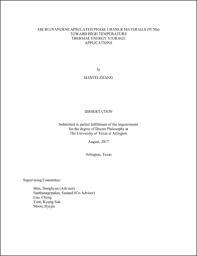
ATTENTION: The works hosted here are being migrated to a new repository that will consolidate resources, improve discoverability, and better show UTA's research impact on the global community. We will update authors as the migration progresses. Please see MavMatrix for more information.
Show simple item record
| dc.contributor.advisor | Shin, Donghyun | |
| dc.contributor.advisor | Santhanagopalan, Sunand | |
| dc.creator | Zhang, Hanfei | |
| dc.date.accessioned | 2019-04-10T21:58:56Z | |
| dc.date.available | 2019-04-10T21:58:56Z | |
| dc.date.created | 2017-08 | |
| dc.date.issued | 2017-08-25 | |
| dc.date.submitted | August 2017 | |
| dc.identifier.uri | http://hdl.handle.net/10106/27965 | |
| dc.description.abstract | Thermal energy is one of the most important renewable energy sources because of its abundancy. However, despite the long history of people practically trying to harvest thermal energy, the efficiency of thermal energy storage and application to daily life utilization is still a major limitation, especially for high temperature (>300oC) applications. Concentrating solar power (CSP) is one of the very few technologies that have been used commercially to produce electricity from solar thermal energy. Benefiting from the extra latent heat stored during melting/freezing, phase change materials (PCMs) with a high melting point are commonly used in these systems functioning as thermal energy storage (TES) and heat transfer fluid (HTF). Further, to avoid contamination from surroundings and increase heat transfer rate, tremendous effort has been dedicated to make micro/nano-sized PCMs encapsulations. Yet, until now, most of the successful micro/nano-encapsulation techniques are not compatible with high temperatures due to the poor thermal/chemical stability of the capsules. A novel and cost effective modified sol-gel process was developed for the encapsulation of the first ever salt@silica microcapsules, which showed excellent thermal stability and reliability at high temperature. The encapsulation process was studied in detail and shown to be precisely controllable, demonstrated by different encapsulation ratios and shell thicknesses obtained. Rheological properties and thermal performance of microcapsules added HTF (solar salt) were then analyzed with the highest effective heat capacity enhancement of 11.0% obtained. Binary carbonate salt micro particles were then encapsulated via the same method. Through the high specific heat and latent heat of the binary carbonate salt, remarkable 40.5% and 134.4% enhancement on effective heat capacity over the best commercialized product was achieved respectively for active and passive solar thermal systems. Finally, the versatility of the developed encapsulation technique was demonstrated by micro/nano-encapsulation of different materials, along with the possibility of void creation. | |
| dc.format.mimetype | application/pdf | |
| dc.language.iso | en_US | |
| dc.subject | Micro-encapsulation | |
| dc.subject | Nano-encapsulation | |
| dc.subject | Thermal energy storage | |
| dc.subject | Phase change material | |
| dc.subject | High temperature | |
| dc.subject | Molten salt | |
| dc.subject | Concentrating solar power | |
| dc.subject | Silica | |
| dc.subject | Sol-gel | |
| dc.subject | Core/shell | |
| dc.subject | Nanofabrication | |
| dc.title | Micro/Nanoencapsulated Phase Change Materials (PCMs) toward High Temperature Thermal Energy Storage Applications | |
| dc.type | Thesis | |
| dc.degree.department | Mechanical and Aerospace Engineering | |
| dc.degree.name | Doctor of Philosophy in Mechanical Engineering | |
| dc.date.updated | 2019-04-10T22:00:01Z | |
| thesis.degree.department | Mechanical and Aerospace Engineering | |
| thesis.degree.grantor | The University of Texas at Arlington | |
| thesis.degree.level | Doctoral | |
| thesis.degree.name | Doctor of Philosophy in Mechanical Engineering | |
| dc.type.material | text | |
| dc.creator.orcid | 0000-0001-6595-396X | |
Files in this item
- Name:
- ZHANG-DISSERTATION-2017.pdf
- Size:
- 6.482Mb
- Format:
- PDF
This item appears in the following Collection(s)
Show simple item record


